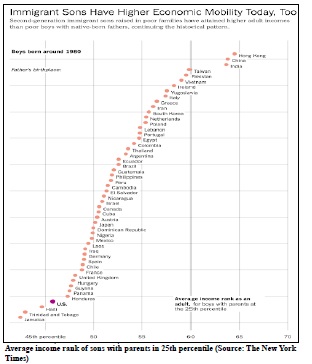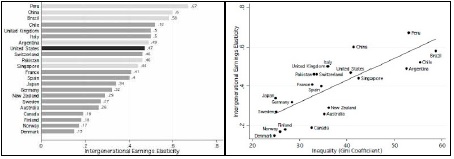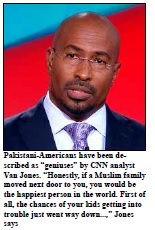Pakistani-Americans among Top 5 Upwardly Mobile Groups in the United States
By Riaz Haq

A recent study shows that Pakistani-Americans are among the five most upwardly mobile groups in the United States. Other top most upwardly groups are Chinese-Americans from Hong Kong, Taiwan and People's Republic of China and Indian-Americans.
US Offers Upward Mobility For Immigrants
Immigration to the United States continues to offer a route to escape poverty — if not for poor immigrants themselves, then for their sons, according to a study published by a team of economic historians at Princeton, Stanford and the University of California, Davis.
The study shows the adult outcomes of sons born in 1980 who grew up in poor families at about the 25th percentile of income distribution in the United States. Pakistani-American sons born in poor households are now at 59th percentile of income in the United States.
Sons of immigrants from Hong Kong in 25th percentile have the highest economic mobility and are 64th percentile followed by China at 63rd, India at 62nd and Taiwan at 60th percentile. Sons of American born fathers are at 46th percentile, much lower than for the sons of immigrants. Only the sons of immigrants from the Caribbean island nations of Haiti, Trinidad and Tobago, and Jamaica have lower mobility.

Economic Mobility in Pakistan
A 2012 study of 22 nations conducted by Prof Miles Corak for the Organization of Economic Cooperation and Development (OECD) has found income heritability to be greater in the United States, the United Kingdom, Italy, China and 5 other countries than in Pakistan.
The study's findings, presented by the author in testimony to the US Senate Finance Committee on July 6, 2012, rely on the computation of "inter-generational earnings elasticity" which the author explains as follows:
"(It) is the percentage difference in earnings in the child’s generation associated with the percentage difference in the parental generation. For example, an intergenerational elasticity in earnings of 0.6 tells us that if one father makes 100% more than another then the son of the high income father will, as an adult, earn 60% more than the son of the relatively lower income father. An elasticity of 0.2 says this 100% difference between the fathers would only lead to a 20% difference between the sons. A lower elasticity means a society with more mobility."
Intergenerational Mobility in Pakistan
Corak calculates that the intergenerational earnings elasticity in Pakistan is 0.46, the same as in Switzerland. It means that a difference of 100% between the incomes of a rich father and a poor father is reduced to 46% between their sons' incomes. Among the 22 countries studied, Peru, China and Brazil have the lowest economic mobility with inter-generational elasticity of 0.67, 0.60 and 0.58 respectively. The highest economic mobility is offered by Denmark (0.15), Norway (0.17) and Finland (0.18).
The author also looked at Gini coefficient of each country and found reasonably good correlation between Gini and intergenerational income elasticity.
BeidesCorak, there are other reports which confirm that Pakistan has continued to offer significant upward economic and social mobility to its citizens over the last two decades. Since 1990, Pakistan's middle class has expanded by 36.5% and India's by only 12.8%, according to an ADB report titled "Asia's Emerging Middle Class: Past, Present And Future".
More evidence of upward mobility is offered by recent Euromonitor market research indicating that Pakistanis are seeing rising disposable incomes. It says that there were 1.8 million Pakistani households (7.55% of all households) and 7.9 million Indian households (3.61% of all households) in 2009 with disposable incomes of $10,001 or more. This translates into 282% increase (vs 232% in India) from 1995-2009 in households with disposable incomes of $10,001 or more. Consumer spending in Pakistan has increased at a 26 percent average pace the past three years, compared with 7.7 percent for Asia, according to Bloomberg.
Geniuses from Pakistan
Pakistani-Americans have been described as "geniuses" by CNN analyst Van Jones. Here's Jones talking about Muslim-Americans and Pakistani-Americans in 2016:
"Honestly, if a Muslim family moved next door to you, you would be the happiest person in the world. First of all, the chances of your kids getting into trouble just went way down. OK, went way down.
“Because (American) Muslim community has the lowest crime rate, the highest entrepreneurship, the highest educational attainment for women in the country (US). They are the model American community.
“And so, when you have people who are now afraid to come here--that's starting to happen--you have geniuses from Pakistan, who are from Indonesia, who now (think to themselves) ‘I'm not safe here’.
“That becomes an economic problem for America long term. So that we're starting to do stuff here that doesn't make good sense for what has made us great so far."
Summary:Pakistani-Americans are among the top 5 groups in terms of upward economic mobility, according to a study by researchers at Princeton, Stanford and UC Davis. Other immigrant groups with high mobility in America include Chinese and Indians. A 2012 study of 22 nations conducted by Prof Miles Corak for the Organization for Economic Cooperation and Development (OECD) has found income heritability to be greater in the United States, the United Kingdom, Italy, China and 5 other countries than in Pakistan. Pakistani-American have been described as "geniuses" by CNN analyst Van Jones.
https://www.youtube.com/watch?v=gr5cLv8Dj2I

-----------------------------------------------------------------------------

